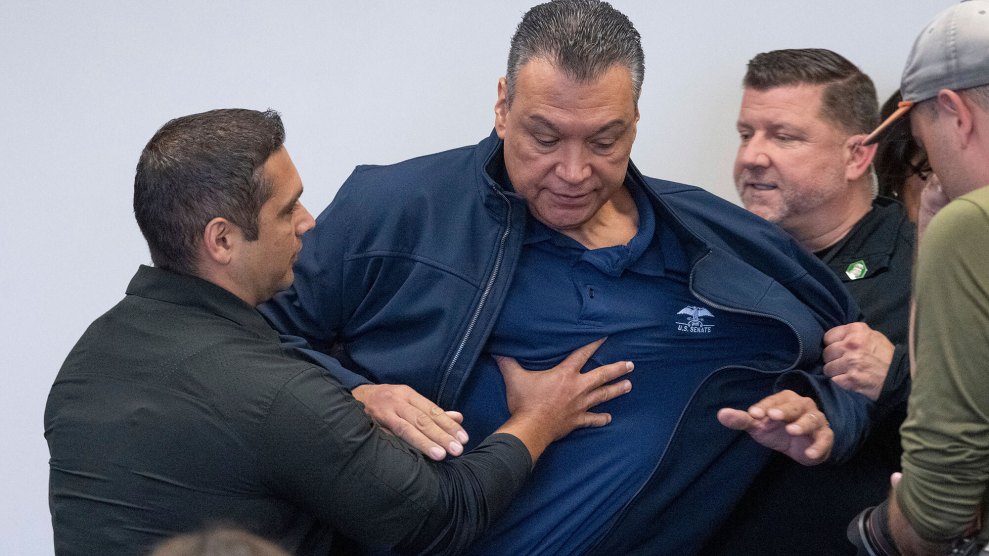Note: Reader responses to this article are available for viewing online
In war, it often takes a disinterested third party to bring combatants to the peace table, and that may just be happening right now with mainstream physicians and practitioners of homeopathy, an alternative therapy based on diluted natural substances that has long been dismissed by the U.S. medical establishment as quackery. Though largely ignored by the media, the results of experiments by Shui-Yin Lo, a former visiting associate in chemistry at California Institute of Technology, may, after almost two centuries, finally begin to explain scientifically how homeopathy works.
First practiced by German doctor Samuel Hahnemann in the early 1800s as a nontoxic alternative to the standard medical practices of his day (bleeding, leeches, and mercury), the logic of homeopathy rests on two main principles. Hahnemann treated ailing people with microscopic doses of the same substances (herbs, minerals, animal parts) that would cause their symptoms in healthy people. He dubbed this the Law of Similars (which led to the term “homeopathy”). It appears to work not unlike modern vaccinations, which use a tiny amount of a deactivated germ to stimulate an immune response, and thus protect people from the disease caused by larger amounts of the same germ.
Hahnemann also believed that homeopathic medicines get stronger as they become more dilute. But this second homeopathic principle, which he called the Law of Potentization, directly contradicts a central tenet of pharmacology: the “dose-response relationship,” the idea that to increase a drug’s effect, you must use a larger dosage. Not so, according to homeopaths, who often claim good results with medicines so dilute that in all probability they contain not a single molecule of the original substance—somehow “remembering” the diluted substance and retaining its “essence.”
For anyone with even a passing acquaintance with pharmacology, the Law of Potentization is hard to swallow. Oncologist Wallace Sampson, a professor at Stanford, has dismissed it as “not biologically plausible.” Any benefits, he says, are the result of “suggestion,” and “a placebo effect.” Stephen Barrett of Allentown, Pennsylvania, a board member of the National Council for Reliable Health Information, is even less kind, calling the theory “utter nonsense.” If extremely diluted substances can impart their “essence” to water, Barrett argues, then “every substance encountered by a molecule of water might imprint an ‘essence’ that could exert powerful (and unpredictable) medicinal effects when ingested.” (Homeopaths counter that homeopathic medicines require distilled water and vigorous shaking between dilutions.) Barrett, who considers homeopathy a fraud, says it should be banned.
But Lo’s findings may bolster the homeopathic cause. Although he has nothing to do with the alternative therapy—and wants no part of it—his experiments appear to give its advocates some independent scientific support. Two years ago, Lo created extremely dilute solutions using a technique similar to Hahnemann’s. Training an electron microscope on them, he discovered that in some cases the water contained bizarre ice crystals that didn’t behave anything like the stuff that comes from the freezer. This strange new type of ice, which forms in solutions at temperatures well above freezing, gives off a unique electrical field. Lo calls these crystals “IE”—ice with an electrical field.
Building on Lo’s work, Benjamin Bonavida, an immunology professor at the University of California-Los Angeles, discovered in 1997 that water with the biologically active IE crystals significantly increases the production of several components of the immune system—stimulating up to 100 times more biological activity than plain water.
The implication, maintains Dana Ullman, director of Homeopathic Educational Services in Berkeley, California, is that homeopathic medicines work by creating IE crystals that stimulate the immune system. Yet promoting this link may prove difficult. Ullman says the prejudice against homeopathy in the U.S. makes it impossible for any scientist here to undertake its study, asserting that the fear of being professionally ostracized is “equivalent to the Red scare.”
Homeopathy did not always receive such a blanket condemnation from the American medical community. Brought here from Europe in 1825, it quickly won supporters among doctors fed up with bleeding, leeches, and mercury. By 1844, homeopaths had launched the American Institute of Homeopathy. Three years later, mainstream doctors formed the American Medical Association, which waged a fierce campaign against the alternative medicine. State legislatures began licensing only those physicians who had graduated from medical institutions like Johns Hopkins, and by 1948, the last homeopathic school in the nation closed. By the early 1970s, there were fewer than 100 homeopaths in the U.S.
Homeopathy has always fared far better in Europe, where many mainstream doctors include elements of homeopathy in their practice.
But during the past 25 years, the U.S. has witnessed a modest homeopathic renaissance. An estimated 5,000 health professionals now include homeopathy in their practices, and a growing body of research shows that homeopathic treatment produces real benefits.
A 1991 review of homeopathic studies, conducted by Dutch epidemiologists at the University of Limburg, concluded that homeopathy could be considered a “regular treatment for certain indications,” including hay fever, pain, and respiratory conditions (colds, flu, bronchitis, and sinus infections). In 1994, Scottish researchers studied 28 people whose asthma attacks were triggered primarily by exposure to household dust mites. Those taking homeopathic preparations suffered significantly fewer attacks than those taking placebos. Last year, German and American researchers analyzed 89 scientific studies of homeopathy worldwide, finding that homeopathy worked significantly better than placebos.
Homeopaths prescribe treatment based on a patient’s individual symptoms. Two people with what mainstream doctors would consider the same illness might get different homeopathic medicines if their overall symptoms differ even slightly.
Homeopaths prescribe medicines that are altogether different from mainstream drugs. They usually come in the form of tiny pellets and have strange-sounding Latin names, ranging from the familiar—Allium cepa (onion), Natrum mur (sodium chloride, i.e., salt), or Chamomilla (chamomile)—to the bizarre or seemingly dangerous—Rhus tox (poison ivy), Arsenicum (arsenic), Tabacum (tobacco), or Lachesis (venom of the bushmaster snake). But proponents assert that they’re not dangerous in homeopathic doses, and the Food and Drug Administration agrees. They’re exempt from regulation and available over the counter at most health food stores.
For a national directory of licensed health professionals who use homeopathy, contact: Homeopathic Educational Services, 2124 Kittredge St., Berkeley, CA 94704, (510) 649-0294; or the National Center for Homeopathy, 801 N. Fairfax St., Suite 306, Alexandria, VA 22314, (703) 548-7790.
















